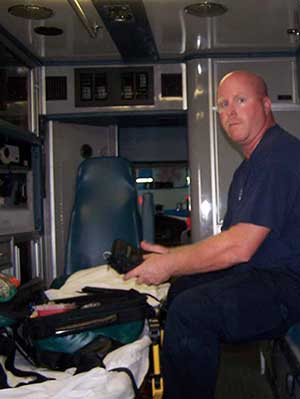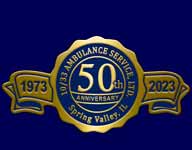Emergency Medical Technician's
EMT-Basic
Education: CEU: 60 hrs in 4 years.
The Emergency Medical Technician - Basic (EMT-B) is a basic level provider of Emergency Medical Services and perform under supervision of a higher level EMT or a doctor or nurse. EMT-B's provides the following:
- Cardiopulmonary Resuscitation
- External Defibrillation
- Oxygen administration
- Glucometry
- Airway management
- Spinal immobilization
- Traction splinting
- Bleeding control
- Treatment of shock
- Bandaging wounds
- Assist patients to administer prescribed nitroglycerin, metered dose inhalers and epinephrine auto injectors
- And other health needs of an emergency nature until such time as a more qualified person can take over
EMT-Basic's within the United States may differ in their skills and education requirements from each district.
Paramedic
Education: CEU: 100 hrs in 4 years.
The Paramedic (EMT-P) include all the EMT-B and the following:
- Cardiac monitoring/defibrillation

- Intravenous therapy
- Intraosseous Infusion
- Endotracheal intubation
- Oxygen administration
- Advanced Life Support
- Asthma and respiratory crisis intervention
- Treatment of anaphylaxis/severe allergic reactions
- Drug therapy for diabetic shock and seizures
- Pharmalogical stabilization of cardiogenic shock
- Intravenous therapy
- Intraosseous infusion
- Airway management
- Visualization the airway by use of the laryngoscope
- Endotracheal intubation
- Esophageal intubation laryngeal mask airway or a combitube
- Continuous positive airway pressure (CPAP)
- Pulse oximetry and CO2 & ETCO2 monitoring
- Needle decompression
- Advanced Cardiac Life Support (ACLS)
- Cardiac monitoring and interpretation of 12 lead ECG
- Defibrillation
- Synchronized cardioversion
- Cardiac pacing
- Pediatric care, such as Pediatric Advanced Life Support (PALS) or Pediatric Education for Prehospital Professionals (PEPP)
- Administration of medications that include: Adenosine, Atropine, Dextrose 50%, Diazepam, Diphenhydramine, Epinephrine, Fentanyl, Glucagon, Morphine Sulfate, Lidocaine, Naloxone, Sodium Bicarbonate, Toradol and Zofran are generally used
Critical Care Paramedic
Education: : Paramedic CEU's with an additional 12 hours per year of education to maintain advance certifications.
The Critical Care Paramedic (CCEMT-P) skills include the paramedic level and advance certification for the following:
- Central venous access
- Rapid Sequence Intubation (RSI)
- Ventilator management
- Chest tube management
- Nasal gastric tube and oral gastric tube
- PCA Pumps
- IV chemical sedation and analgesia
- Trauma care, such as Prehospital Trauma Life Support (PHTLS) or International Trauma Life Support (ITLS)
- Rapid trauma assessment on the patient’s physiological condition to prevent secondary injury
- Trauma assessments about the patient, patient with disabilities, breathing and airway management, circulation, shock or hemorrhage conditions
- Pediatric and geriatric trauma


